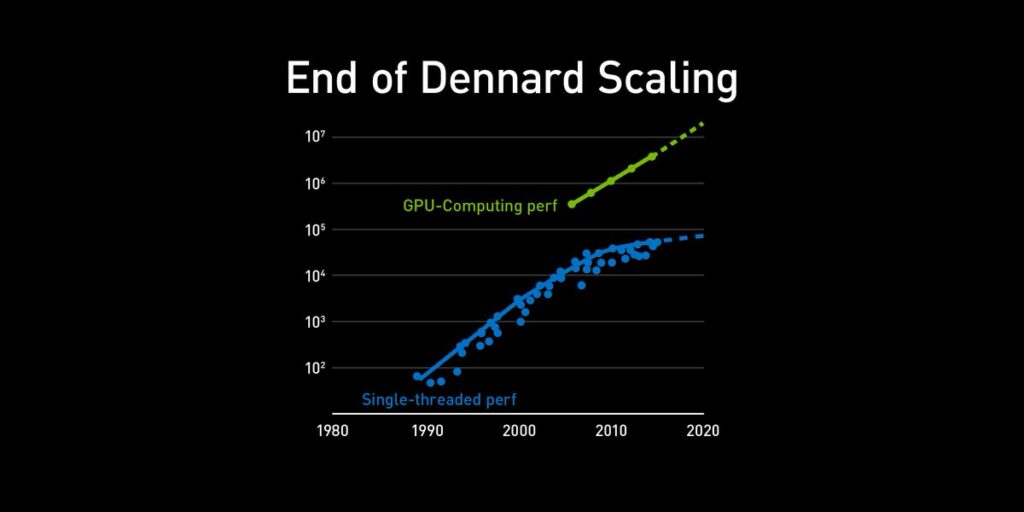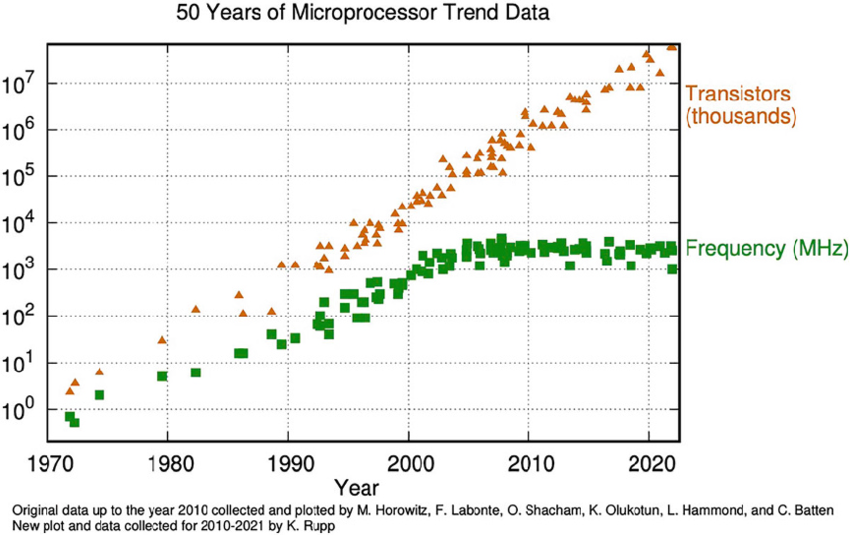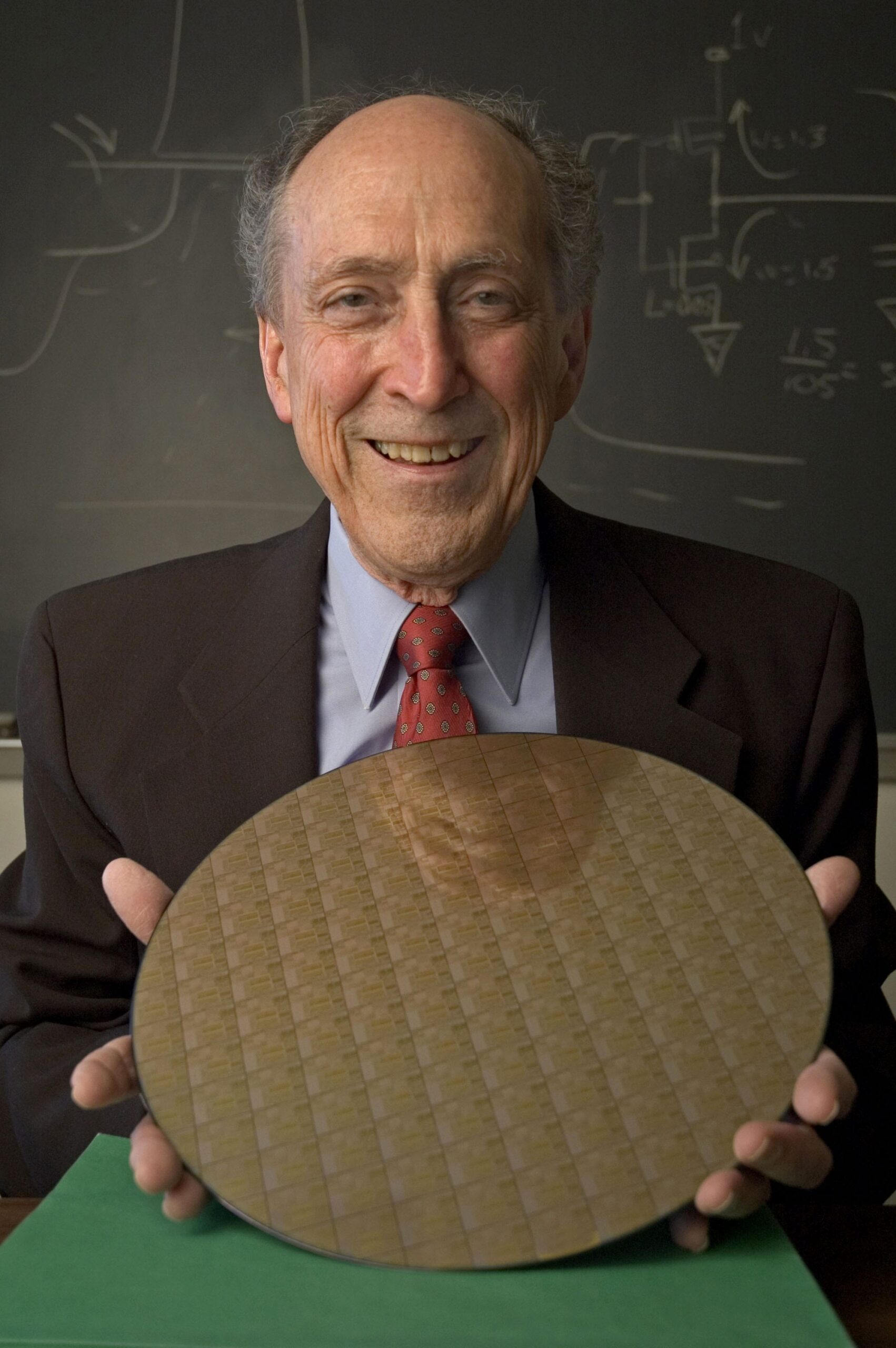Dennard Scaling in Electronics: A Journey of Power Efficiency
In the world of technology, two important rules have shaped how our devices become faster and better: Moore’s Law and Dennard Scaling. These rules work together to make our gadgets awesome. Let’s take a closer look at how they team up to make cool stuff happen.
We need to find new ways to improve the performance and power efficiency of chips if we want to continue the trend of Moore’s law.
– TSMC CEO C.C. Wei
Moore’s Law and Dennard Scaling are two sides of the coin that revolutionized the modern world by enabling smaller, faster, and more energy-efficient electronic devices. Here’s how they work together:
Moore’s Law: proposed by Gordon Moore in 1965, states that the number of transistors on a microchip roughly doubles every two years. This means that we can cram more and more processing power into a smaller and smaller space.
Dennard Scaling: developed by Robert Dennard in 1974, describes how transistors could be shrunk while maintaining constant power consumption. By reducing the size of the transistors, Dennard showed how to keep the power density (heat generated per unit area) constant.

Moore’s Law: The Growth Spurt Rule
Imagine if every two years, the number of tiny switches on a computer chip doubled. That’s what Moore’s Law says.
It’s like watching a tower of building blocks getting taller and taller really quickly. This helps make computers and gadgets more powerful over time.
Read more: Why Moore’s law is not a law?
Dennard Scaling: The Energy Saver Rule
Now, think about these tiny switches. When they’re made smaller, they use less energy. That’s what Dennard Scaling is about.
It’s like making your toys smaller so they need less power to work. This keeps our devices from getting too hot and using up too much energy.
Dennard scaling was the golden rule of the semiconductor industry for many years
~ Mark Bohr, Intel Fellow
Dennard Scaling & Moore’s law: The magic together:
Moore’s Law gives us the ability to pack more power into a chip, but without Dennard Scaling, these chips would be power-hungry monsters. Dennard Scaling tackles this issue by allowing transistors to shrink while keeping their energy consumption in check.

This perfect teamwork has led to:
Smaller and lighter devices: Laptops that were once the size of suitcases are now thin and light. Mobile phones that were once clunky bricks are now powerful pocket computers.
Increased functionality: With more transistors available, we can add more features to our devices, like high-resolution cameras, complex games, and powerful video editing capabilities.
Improved battery life: Thanks to Dennard Scaling, our devices don’t need to be tethered to a wall outlet all the time. We can enjoy longer battery life on our laptops and smartphones.pen_spark
What Dennard Scaling does?
Dennard’s model of MOSFET scaling gives us a way to make electronic parts smaller with each new technology upgrade. Imagine we have a shrinking machine that reduces these parts by 30%.
Here’s what happens when we use this shrinking machine:
- The size of each part becomes 30% smaller, making them take up less space.
- The way these parts store energy becomes 30% less, which helps them use less power.
- We also need to adjust the energy they use, so we make the energy they get 30% less too.
- Other things like how fast they work and how much power they need also become 30% less.
Because of all these changes, the parts can work faster, about 40% faster to be exact. They also use less power, about 50% less.
So, even though they’re smaller, they become more efficient and faster.
In simple terms, this means that every time we make these parts smaller using Dennard’s model, they become faster, use less power, and fit better in our devices.
The Golden Era of Faster, Powerful, and Efficient Devices
Back in the day, Dennard scaling was a game-changer. It enabled engineers to boost the power of devices without draining excessive energy.
Think about it: we could have faster computers, smarter phones, and sleeker gadgets without worrying too much about batteries draining like sand through fingers.
The beauty of this rule was that it made technology advancement feel like a breeze, as we harnessed more power without the dreaded energy consumption spike.
When Good Things Start to Face Challenges
But, like all great things, Dennard scaling eventually hit some roadblocks. As we pushed the boundaries of miniaturization, making things incredibly tiny became a tad bit tricky.
These tiny parts, while super-efficient, started generating more heat – not something you’d want in your palm-sized device!
This posed challenges for devices that have limited space to handle excessive heat.
Moore’s Law worked really well for over 50 years, helping us make computers and devices more powerful.
But, as time went on, it became harder to keep getting those same advantages from it. Around 2005-2006, Dennard’s Scaling seemed to stop working as well. This caused some issues.
One big problem was that the computers couldn’t work within the same power limits as before.
This forced the computer industry to come up with a new idea: instead of making one super powerful part, they started using multiple smaller parts, like having several mini-computers in one.
Adapting and Innovating: The New Chapter
In this era of challenge and change, engineers and scientists haven’t thrown in the towel. Instead, they’ve embraced the need to adapt and innovate.
While Dennard scaling might not be the ultimate guiding light anymore, it’s not the end of the road either.
The tech world is buzzing with ideas like stacking electronic parts on top of one another, experimenting with novel materials, and even crafting ingenious circuit designs.
The mission?
To create devices that are not just powerful but also efficient, overcoming the obstacles that the end of Dennard scaling brought with it.
Our favorite gadgets might be getting smarter and sleeker in different ways, but the pursuit of excellence is alive and well.
The Takeaway: A Future of Promise
In a nutshell, Dennard scaling isn’t just a forgotten rule in a dusty old book. It’s a reminder of how far we’ve come in the journey of electronics.
It’s a testament to human ingenuity and the tireless pursuit of advancement. While it might no longer be the sole driving force behind the scenes, its impact is undeniable.
The path ahead might have a few bumps, but if history has taught us anything, it’s that innovation finds a way.
So, the next time you marvel at your lightning-fast smartphone or immerse yourself in the world of cutting-edge technology, take a moment to appreciate the unsung hero:
Dennard scaling, the spark that ignited a revolution in power efficiency and set us on a course toward a promising future.




